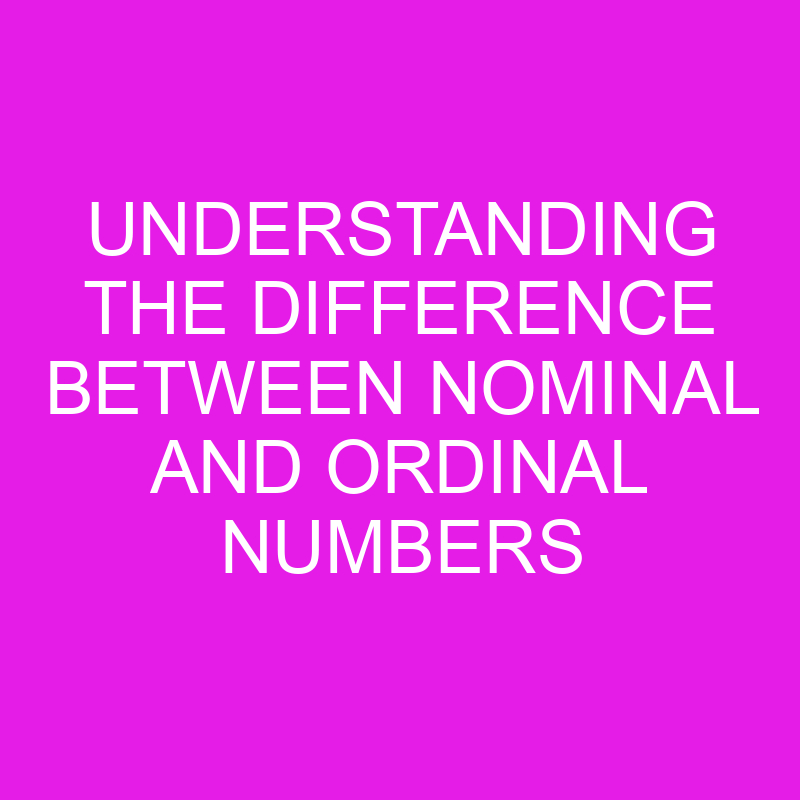
Have you ever wondered about the difference between nominal and ordinal numbers? As a math enthusiast, I’ve often found myself pondering over this very question. Understanding the distinction between these two types of numbers is crucial in various fields, from statistics to data analysis. In this article, I’ll delve into the intricacies of nominal and ordinal numbers, breaking down their definitions and highlighting their unique characteristics. So, if you’re ready to enhance your mathematical knowledge, let’s dive right in and explore the fascinating world of nominal and ordinal numbers.
Post Contents
- Key Takeaways
- What Are Nominal Numbers?
- Characteristics of Nominal Numbers
- Examples of Nominal Numbers
- What Are Ordinal Numbers?
- Characteristics of Ordinal Numbers
- Examples of Ordinal Numbers
- Key Differences Between Nominal and Ordinal Numbers
- Applications of Nominal and Ordinal Numbers
- Conclusion
- Frequently Asked Questions
Key Takeaways
- Nominal numbers represent categories or labels, while ordinal numbers represent rankings or positions.
- Nominal numbers have no inherent order or ranking, while ordinal numbers have a specific order.
- Nominal numbers are often represented by words or symbols, while ordinal numbers can be represented in both words and symbols.
- Nominal numbers are used for organizing and categorizing data, particularly in analyzing qualitative data and understanding patterns and relationships.
- Understanding the characteristics and differences between nominal and ordinal numbers is essential for accurate interpretation and analysis of data.
- Nominal numbers are used in surveys, research studies, statistical analysis, business and marketing, and information organization, while ordinal numbers are used in sports rankings, statistical analysis, business and marketing, and information organization.
What Are Nominal Numbers?
Nominal numbers are a fundamental concept in mathematics and statistics. They are a type of number that represents categories or labels, rather than quantities or values. Understanding nominal numbers is crucial in various fields, including data analysis and statistics, as they play a significant role in organizing and categorizing data.
Here are a few key characteristics of nominal numbers:
- Nominal numbers do not have any inherent order or ranking. They simply identify different categories or groups. For example, in a survey asking for favorite colors, the responses might include “red,” “blue,” and “green” as nominal numbers.
- Nominal numbers are often represented by words, letters, or symbols. In statistical analysis, these categories are assigned numerical codes for convenience, but these codes hold no mathematical significance themselves.
- Unlike ordinal numbers, which we will discuss later, the numerical values of nominal numbers have no quantitative meaning. For example, if we assign the codes 1, 2, and 3 to the nominal categories “red,” “blue,” and “green,” respectively, it does not imply that one color is greater or less than another.
- Nominal numbers can be used to analyze categorical data and determine frequencies or proportions of different categories within a dataset. They are particularly useful in analyzing qualitative data and understanding patterns and relationships.
nominal numbers are a way to represent categories or labels without any inherent order or ranking. They are crucial in organizing and analyzing data, especially in fields like statistics and data analysis. Understanding the distinction between nominal and ordinal numbers is essential for accurate interpretation and analysis of data.
Characteristics of Nominal Numbers
When it comes to understanding and analyzing data, it is crucial to have a clear understanding of the different types of numbers. In this section, let’s dive deeper into the characteristics of nominal numbers.
1. Categories or Labels:
Nominal numbers represent categories or labels rather than quantities or values. They are used to classify and group data into distinct categories. For example, if we are analyzing data on favorite colors, the colors themselves would be considered nominal numbers. Each color represents a distinct category or label.
2. Lack of Inherent Order or Ranking:
One of the key characteristics of nominal numbers is that they do not possess any inherent order or ranking. This means that the categories represented by nominal numbers cannot be arranged in a specific order from highest to lowest or vice versa. Using the same example of favorite colors, it would be incorrect to assign a numerical value or ranking to each color as there is no inherent order or hierarchy among them.
3. Representation by Words or Symbols:
Instead of using numerical values, nominal numbers are represented by words or symbols. This allows for easy identification and categorization of different groups or categories. The use of words or symbols ensures clarity and avoids any confusion in understanding the data being analyzed.
4. Analyzing Categorical Data:
Given their nature, nominal numbers are particularly useful when analyzing categorical data. Categorical data includes information that falls into different categories or groups, such as gender, occupation, or political affiliation. By utilizing nominal numbers, we can effectively categorize and analyze this type of data to gain insights and make meaningful interpretations.
Understanding the characteristics of nominal numbers is essential for accurate interpretation and analysis of data. It enables us to effectively organize, categorize, and draw meaningful conclusions from the information we are analyzing. So, the next time you come across nominal numbers, remember their distinct characteristics and their importance in data analysis.
Examples of Nominal Numbers
When it comes to understanding the difference between nominal and ordinal numbers, examples can be quite helpful. Let me provide you with a few examples of nominal numbers to give you a clearer picture.
- In a survey, participants are often asked to provide their gender, which can be classified as “male” or “female.” These categories represent nominal numbers as they are labels without any inherent order or ranking.
- Another example of nominal numbers is the classification of colors. We use words like “red,” “blue,” “green,” and “yellow” to categorize different colors. These categories do not have any inherent order or ranking; they simply represent different color labels.
- Moving on, think about the classification of fruits. We categorize them as “apples,” “oranges,” “bananas,” and “strawberries,” based on their distinct attributes. Just like colors, these categories don’t have any inherent order or ranking but are helpful for organizing and labeling different fruits.
- In the field of medicine, we often categorize diseases or medical conditions. For example, we may classify diseases as “cancer,” “diabetes,” “asthma,” or “hypertension.” These categories are again nominal numbers as they represent labels without any inherent order or ranking.
- Finally, in a research study, variables such as “occupation,” “education level,” or “marital status” can be considered nominal numbers because they represent different categories or labels without any specific order or ranking.
These examples demonstrate how nominal numbers are used to represent categories or labels without any inherent order or ranking. They are particularly useful when analyzing categorical data, where the focus is on organizing and labeling rather than quantifying or ordering. Understanding and recognizing these examples will aid in accurate interpretation and analysis of data.
What Are Ordinal Numbers?
Ordinal numbers, unlike nominal numbers, represent the rank or position of items in a sequence or order. They are used to indicate relative rankings and hierarchical relationships.
Here are a few key characteristics of ordinal numbers:
- Ordering: Ordinal numbers have a specific order or ranking. For example, we can say that “John came in first place, while Sarah came in second place.”
- Representation: Ordinal numbers can be represented using both words and symbols. For instance, we can use words such as “first,” “second,” “third,” or symbols such as “1st,” “2nd,” “3rd.”
- No Fixed Interval: Unlike interval or ratio scales, ordinal numbers do not have a fixed interval between each value. The difference between “first” and “second” is not necessarily the same as the difference between “second” and “third.”
- Limited Arithmetic Operations: Arithmetic operations like addition, subtraction, multiplication, and division are limited when working with ordinal numbers. For example, it doesn’t make sense to add “first” and “second” together.
Understanding the concept of ordinal numbers is crucial in various fields, including statistics, rankings, sports, and research studies. They provide a way to compare and analyze data based on rankings or positions.
Now that we have explored the characteristics of both nominal and ordinal numbers, let’s dive deeper into their differences and see how they are used in different contexts.
Characteristics of Ordinal Numbers
Ordinal numbers, unlike nominal numbers, represent the rank or position of items in a sequence or order. Understanding the characteristics of ordinal numbers is crucial in various fields such as statistics, rankings, sports, and research studies. Let’s explore the key characteristics of ordinal numbers:
- Specific Order or Ranking: Ordinal numbers assign a specific rank or position to items in a sequence. Whether it’s a list of top-performing athletes or a ranking of countries by population, ordinal numbers help establish a clear hierarchy.
- Representation using Words or Symbols: Ordinal numbers can be represented using either words or symbols. For example, we may use words like “first,” “second,” and “third,” or symbols like 1st, 2nd, and 3rd. The choice of representation depends on the context and preference.
- Lack of Fixed Interval: Unlike nominal numbers, ordinal numbers do not have a fixed interval or consistent difference between each value. The intervals can vary depending on the specific context. For instance, the difference between the 1st and 2nd place may be significant in a race, but less pronounced in a ranking of customer satisfaction.
- Limited Arithmetic Operations: Ordinal numbers have limitations when it comes to arithmetic operations. While we can determine the difference between two ordinal numbers (e.g., the 3rd place minus the 1st place), we can’t perform other mathematical operations like multiplication or division.
Understanding these key characteristics of ordinal numbers is essential for accurately interpreting and analyzing data in various fields. Whether you’re conducting research, analyzing rankings, or making informed decisions based on data, a solid grasp of ordinal numbers is vital.
Examples of Ordinal Numbers
In this section, I will provide you with some examples of ordinal numbers to give you a better understanding of how they are used in everyday life.
- First, second, third – These are the most common and basic examples of ordinal numbers. We use them to describe the position of something in a sequence. For instance, when you’re organizing a race, you would say that the runner who crosses the finish line before everyone else is in the first position, the runner who finishes next is in the second position, and so on.
- January, February, March – Yes, even months can be used as ordinal numbers. We use them to describe the order of months in a year. For example, January is the first month of the year, February is the second month, and March is the third month. This pattern continues throughout the year.
- Thirteen, twenty-four, fifty-sixth – We often use ordinal numbers when talking about dates. For instance, we might refer to the thirteenth of June, the twenty-fourth of December, or the fifty-sixth anniversary of a particular event.
- Dr. Martin Luther King Jr., King Henry VIII – In names, ordinal numbers are often used to indicate the order of someone’s name in a family or a dynasty. For example, Dr. Martin Luther King Jr. was the second person in his family to be named Martin Luther King. King Henry VIII was the eighth king of England with the name Henry.
- Gold, silver, bronze – Ordinal numbers are also commonly used in sports to denote the ranking of athletes or teams. We often say that the winner receives the gold medal (first place), the runner-up gets the silver medal (second place), and the third-place finisher receives the bronze medal.
These examples illustrate how ordinal numbers are used to indicate the order or position of items in various contexts. Understanding the use of ordinal numbers is crucial for interpreting rankings, organizing data, and accurately conveying information.
Key Differences Between Nominal and Ordinal Numbers
When it comes to understanding numbers and their use in different contexts, it’s essential to grasp the distinctions between various types of numbers. Two commonly used types are nominal numbers and ordinal numbers. While both types classify and order items, they have distinct characteristics that set them apart.
Here are the key differences between nominal and ordinal numbers:
- Definition: Nominal numbers are used to label or categorize items, without any inherent order or ranking. On the other hand, ordinal numbers represent the rank or position of items in a sequence or order.
- Representation: Nominal numbers are often represented by names or labels, such as colors, names of countries, or categories in a survey. In contrast, ordinal numbers are represented by words or symbols that indicate the order or position of items, such as “first,” “second,” “third,” or using numerical symbols like 1st, 2nd, 3rd, and so on.
- Hierarchy: Nominal numbers do not possess any hierarchical relationship, as their purpose is to classify items into different groups or categories. In contrast, ordinal numbers explicitly indicate the hierarchical relationship between items, as they represent their positions in a sequence or ordered arrangement.
- Arithmetic Operations: Nominal numbers do not lend themselves well to arithmetic operations. You can’t perform mathematical operations like addition, subtraction, multiplication, or division using nominal numbers. Conversely, ordinal numbers can be subject to arithmetic operations, but the resulting values may not have any logical or meaningful interpretation.
Understanding the key differences between nominal and ordinal numbers is crucial for accurately interpreting and utilizing them in various fields, including statistics, research studies, and data analysis. By recognizing the distinct characteristics and purposes of nominal and ordinal numbers, you can effectively organize and communicate information, making your work more coherent and understandable. Remember, numbers play a pivotal role in conveying the order, rank, and classification of items in different contexts.
Applications of Nominal and Ordinal Numbers
When it comes to understanding and utilizing nominal and ordinal numbers, it is important to know their applications in various fields. These applications can help us make sense of data, rankings, and hierarchies. Let’s explore some of the key areas where nominal and ordinal numbers are commonly used:
1. Surveys and Research Studies: In surveys and research studies, nominal numbers are often used to categorize responses. For example, participants might be categorized by their age group or gender. On the other hand, ordinal numbers are used to rank participants’ preferences or opinions. This allows researchers to analyze and compare data in a meaningful way.
2. Sports Rankings: Nominal and ordinal numbers play a crucial role in ranking sports teams and athletes. Nominal numbers are used to label teams or individuals, while ordinal numbers indicate their position or rank in a tournament or league. This helps determine the overall winner, as well as individual rankings within a competition.
3. Statistical Analysis: In the field of statistics, nominal and ordinal numbers are used to classify and analyze data. Nominal numbers are used to label different categories or groups, while ordinal numbers are used to represent the rank or order of data points. Understanding these distinctions is essential for conducting accurate statistical analyses and drawing meaningful conclusions from data.
4. Business and Marketing: Nominal and ordinal numbers find applications in business and marketing as well. Nominal numbers are used to categorize customer demographics, product categories, or market segments. On the other hand, ordinal numbers can be used to rate customer satisfaction, measure customer loyalty, or rank products based on customer preferences.
5. Information Organization: Nominal and ordinal numbers are also used for organizing and classifying information. Nominal numbers help categorize items or files, while ordinal numbers provide a hierarchical structure. This is particularly useful in libraries, databases, and file systems, where organizing and retrieving information becomes easier using these numerical systems.
Understanding the applications of nominal and ordinal numbers is key to accurately interpreting and utilizing them in various fields. Whether it’s analyzing data, conducting research studies, ranking sports teams, or organizing information, knowing the distinction between these numerical systems is essential.
As we continue to delve into the topic, let’s explore in further detail the differences in representation, hierarchy, and arithmetic operations between nominal and ordinal numbers.
Conclusion
Understanding the difference between nominal and ordinal numbers is crucial in various fields. Nominal numbers are used for categorization and labeling, while ordinal numbers represent rank or position in a sequence. This knowledge is particularly important in surveys, research studies, sports rankings, statistical analysis, business and marketing, and information organization.
By grasping the distinction between nominal and ordinal numbers, we can accurately interpret and utilize them in these areas. For instance, in surveys and research studies, nominal numbers help categorize responses and analyze data based on different variables. In sports rankings, ordinal numbers determine the position of teams or players. In statistical analysis, nominal numbers aid in grouping data, while ordinal numbers provide valuable insights into rankings and preferences.
Moreover, understanding nominal and ordinal numbers is vital in business and marketing. Nominal numbers help segment customers into different categories, while ordinal numbers assist in analyzing customer preferences and behaviors. In information organization, nominal numbers are used for classification, while ordinal numbers establish hierarchical structures.
A clear understanding of nominal and ordinal numbers is essential for accurately interpreting and utilizing them in various fields.
Frequently Asked Questions
Q: What are nominal numbers used for?
A: Nominal numbers are used to categorize items or label different categories.
Q: What are ordinal numbers used for?
A: Ordinal numbers are used to represent the rank or position of items in a sequence or order.
Q: Why is it important to understand nominal and ordinal numbers?
A: Understanding nominal and ordinal numbers is important for accurately interpreting and utilizing them in surveys and research studies, sports rankings, statistical analysis, business and marketing, and information organization.






